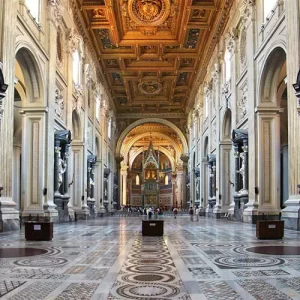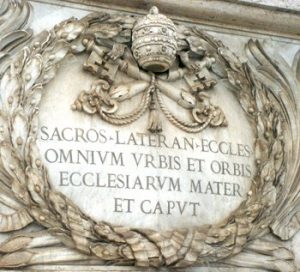Ord Om ordet
Jubelårsmesse i Lateranet
Preken holdt i Lateranbasilikaen ved åpningen av den nordiske jubelårspilegrimsferden til Roma.
Isaiah 61.1-9: A garland instead of ashes.
Luke 4.16-21: Today this scripture has been fulfilled.
Our readings place us within a tension we know well: the tension between expectation and accomplishment. Isaiah’s prophecy speaks of broken hearts, unfreedom, faintness of spirit. We know about these things; life teaches us the lessons. To be human is at times to experience great desolation. We recognise this in a general way, but what about us who believe in God? Shouldn’t we expect to be kept safe? No. Faith is no insurance policy; nor is it virtual reality. Believers are not exempt from the lot of humanity at large; often they have a lion’s share in it. This is clear from Scripture and from the lives of the saints. The essential difference faith makes is this: it inspires certainty that no misery is final; that everything mysteriously ‘works unto good for those who love God’. To have faith in a gracious, all-powerful yet patient God is to trust doggedly that darkness may turn into light, then to verify this transformation autobiographically. Astonished, we see that the ashes scattered on our heads in grief have the makings of a joyful garland, even as our faint, constricted spirit unfolds into a multicoloured, ennobling mantle of praise.
 Israel kept this perspective alive for centuries as an antidote against the prevailing view of things, a view (still current) maintaining that there is no such thing as grace; that life is a transactional business in which only cunning matters; that nothing really means anything; and that suffering has no purpose. Israel’s flame of hope was carried through the night, perceptible in glimmers. Then dawn came. Daylight erupted when, in a synagogue in Nazareth, Isaiah’s ancient words were read and a Man stepped forward saying: ‘Today this scripture has been fulfilled’. For those who stake their lives on those words, and we would be such, hope is reconfigured, lodged henceforth in a Person who displays at once man’s vulnerability and God’s might. That this Person remains alive, present, accessible is the essence of our Christian creed. It strikes us with force as we gather as jubilee pilgrims in this church, the protobasilica of Christendom.
Israel kept this perspective alive for centuries as an antidote against the prevailing view of things, a view (still current) maintaining that there is no such thing as grace; that life is a transactional business in which only cunning matters; that nothing really means anything; and that suffering has no purpose. Israel’s flame of hope was carried through the night, perceptible in glimmers. Then dawn came. Daylight erupted when, in a synagogue in Nazareth, Isaiah’s ancient words were read and a Man stepped forward saying: ‘Today this scripture has been fulfilled’. For those who stake their lives on those words, and we would be such, hope is reconfigured, lodged henceforth in a Person who displays at once man’s vulnerability and God’s might. That this Person remains alive, present, accessible is the essence of our Christian creed. It strikes us with force as we gather as jubilee pilgrims in this church, the protobasilica of Christendom.
The church of St John Lateran has a venerable history. The complex to which the first basilica belonged was home to the Laterani, a consular family. Constantine, the emperor, married into that family. The Lateran came into his hands just after 300 AD. Its destiny was sealed. For once Constantine had pledged this troth to Christ he set the Lateran aside as a centre of worship. Dedicated by Pope St Sylvester in 324, the year before the council of Nicaea, the Lateran became the capital’s baptismal church, the seat of its bishop, and the head of a cruciform pattern of churches drawn to mark the very fabric of this city with the sign of the Glorious Cross. The Lateran won the title it bears still: Omnium urbis et orbis ecclesiarum mater et caput; ‘Mother and Head of every church of the City and of the whole world’. That is why the dedication of the Lateran is kept as a solemn feast throughout the Church each 9 November. The Lateran is ‘Mother and Head’ of our own places of worship even up towards, and beyond, the Arctic Circle. It represents the fountain of which our churches are rivulets. This is all very well, you may say, but are we not caught in a quandary? When Christ announced the fulfilment of Israel’s hope, he pointed to himself, not to bricks and mortar. Is the new sanctuary, subsisting in Christ, not a spiritual reality, a temple not made with human hands?
The tension is real. It points towards a paradox constitutional for Catholics. Ours is an historical religion. Our faith is founded on  things that happened, placeable acts of God in time. Christ came to save this world. He poured himself out for it. He pours himself out still. The Church is the privileged place of his redemptive gift. From within it, his grace gushes forth like a mighty stream bringing healing, health, and teeming life in its wake. When we enter those graced waters, we enter a living communion. What matters about the Lateran, Rome’s cathedral, is this: by its dedication, the mystical Church was shown, urbi & orbi, to be palpable, real. It was placed on the map. Constantine marked this house out as a place of intersection. ‘Here’, he proclaimed, ‘our earthly city encounters that of heaven; here God’s kingdom impinges on ours.’ Like Jacob he discerned, in this transient world, the very house of God. Gathered here, we, too, say: God is with us!
things that happened, placeable acts of God in time. Christ came to save this world. He poured himself out for it. He pours himself out still. The Church is the privileged place of his redemptive gift. From within it, his grace gushes forth like a mighty stream bringing healing, health, and teeming life in its wake. When we enter those graced waters, we enter a living communion. What matters about the Lateran, Rome’s cathedral, is this: by its dedication, the mystical Church was shown, urbi & orbi, to be palpable, real. It was placed on the map. Constantine marked this house out as a place of intersection. ‘Here’, he proclaimed, ‘our earthly city encounters that of heaven; here God’s kingdom impinges on ours.’ Like Jacob he discerned, in this transient world, the very house of God. Gathered here, we, too, say: God is with us!
The Lateran, Mother of churches, stands as a pledge of Catholic communion. It is a wonderful gift. Yet it points beyond itself. Important as places and persons are for our journey in faith, they are signposts, not destinations. A touch of Noli me tangere, of ‘Do not cling to me’, marks all manifestations of grace in this world. They are our viaticum now, but we mustn’t get too attached; we must feed on them to purify our love and our longing to see God as he is, to become like him, in an eternal embrace of love. While striving to conduct our pilgrimage on earth with integrity, in faith, we must set our eyes on our homeland in heaven. That is what we affirm today, standing here as pilgrims of hope. We manifest our readiness to let hope do its thawing, slowly transformative work in us. We give thanks for passing joys even as we press forward towards those that endure. May the graces we receive give joy, zest, and lightness to our Christian lives here and at home, making the centre present in our periphery as we hold up the emblem of Christ’s victory, singing his new song, preparing his reign. Amen.
